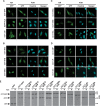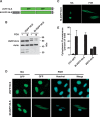Nuclear export of the rate-limiting enzyme in phosphatidylcholine synthesis is mediated by its membrane binding domain
- PMID: 19098306
- PMCID: PMC2666183
- DOI: 10.1194/jlr.M800632-JLR200
Nuclear export of the rate-limiting enzyme in phosphatidylcholine synthesis is mediated by its membrane binding domain
Abstract
CTP:phosphocholine cytidylyltransferase alpha (CCTalpha), the rate-limiting enzyme in the CDP-choline pathway for phosphatidylcholine (PtdCho) synthesis, is activated by translocation to nuclear membranes. However, CCTalpha is cytoplasmic in cells with increased capacity for PtdCho synthesis and following acute activation, suggesting that nuclear export is linked to activation. The objective of this study was to identify which CCTalpha domains were involved in nuclear export in response to the lipid activators farnesol (FOH) and oleate. Imaging of CCT-green fluorescent protein (GFP) mutants expressed in CCTalpha-deficient CHO58 cells showed that FOH-mediated translocation to nuclear membranes and export to the cytoplasm required the membrane binding amphipathic helix (domain M). Nuclear export was reduced by a mutation that mimics constitutive phosphorylation of the CCT phosphorylation (P) domain. However, domain M alone was sufficient to promote translocation to the nuclear envelope and export of a nuclear-localized GFP construct in FOH- or oleate-treated CHO58 cells. In the context of acute activation with lipid mediators, nuclear export of CCT-GFP mutants correlated with in vitro activity but not PtdCho synthesis. This study describes a nuclear export pathway that is dependent on membrane interaction of an amphipathic helix, thus linking lipid-dependent activation to the nuclear/cytoplasmic distribution of CCTalpha.
Figures







Similar articles
-
Induction of apoptosis by lipophilic activators of CTP:phosphocholine cytidylyltransferase alpha (CCTalpha).Biochem J. 2005 Dec 15;392(Pt 3):449-56. doi: 10.1042/BJ20051021. Biochem J. 2005. PMID: 16097951 Free PMC article.
-
CTP:phosphocholine cytidylyltransferase α (CCTα) and lamins alter nuclear membrane structure without affecting phosphatidylcholine synthesis.Biochim Biophys Acta. 2011 Jun;1811(6):377-85. doi: 10.1016/j.bbalip.2011.04.001. Epub 2011 Apr 9. Biochim Biophys Acta. 2011. PMID: 21504799
-
Oxysterol activation of phosphatidylcholine synthesis involves CTP:phosphocholine cytidylyltransferase alpha translocation to the nuclear envelope.Biochem J. 2009 Feb 15;418(1):209-17. doi: 10.1042/BJ20081923. Biochem J. 2009. PMID: 18980580
-
Regulation of CTP:phosphocholine cytidylyltransferase by amphitropism and relocalization.Trends Biochem Sci. 2000 Sep;25(9):441-7. doi: 10.1016/s0968-0004(00)01625-x. Trends Biochem Sci. 2000. PMID: 10973058 Review.
-
CTP:phosphocholine cytidylyltransferase: Function, regulation, and structure of an amphitropic enzyme required for membrane biogenesis.Prog Lipid Res. 2015 Jul;59:147-71. doi: 10.1016/j.plipres.2015.07.001. Epub 2015 Jul 9. Prog Lipid Res. 2015. PMID: 26165797 Review.
Cited by
-
Surfactant phospholipid metabolism.Biochim Biophys Acta. 2013 Mar;1831(3):612-25. doi: 10.1016/j.bbalip.2012.09.010. Epub 2012 Sep 29. Biochim Biophys Acta. 2013. PMID: 23026158 Free PMC article. Review.
-
Phosphatidylcholine Cytidine Transferase α (CCTα) Affects LD Formation Through Fusion and Lipophagy in Bovine Mammary Epithelial Cells.Int J Mol Sci. 2025 Feb 27;26(5):2135. doi: 10.3390/ijms26052135. Int J Mol Sci. 2025. PMID: 40076755 Free PMC article.
-
The putative pocket protein binding site of Autographa californica nucleopolyhedrovirus BV/ODV-C42 is required for virus-induced nuclear actin polymerization.J Virol. 2010 Aug;84(15):7857-68. doi: 10.1128/JVI.00174-10. Epub 2010 May 19. J Virol. 2010. PMID: 20484515 Free PMC article.
-
The intrinsically disordered nuclear localization signal and phosphorylation segments distinguish the membrane affinity of two cytidylyltransferase isoforms.J Biol Chem. 2011 Apr 8;286(14):12349-60. doi: 10.1074/jbc.M110.201715. Epub 2011 Feb 8. J Biol Chem. 2011. PMID: 21303909 Free PMC article.
-
Calcium-calmodulin kinase I cooperatively regulates nucleocytoplasmic shuttling of CCTα by accessing a nuclear export signal.Mol Biol Cell. 2012 Jul;23(14):2755-69. doi: 10.1091/mbc.E11-10-0863. Epub 2012 May 23. Mol Biol Cell. 2012. PMID: 22621903 Free PMC article.
References
-
- Vance J. E., and D. E. Vance. 2005. Metabolic insights into phospholipid function using gene-targeted mice. J. Biol. Chem. 280 10877–10880. - PubMed
-
- Cui Z., and M. Houweling. 2002. Phosphatidylcholine and cell death. Biochim. Biophys. Acta. 1585 87–96. - PubMed
-
- Vance D. E., Z. Li, and R. L. Jacobs. 2007. Hepatic phosphatidylethanolamine N-methyltransferase, unexpected roles in animal biochemistry and physiology. J. Biol. Chem. 282 33237–33241. - PubMed
-
- Lykidis A., and S. Jackowski. 2001. Regulation of mammalian cell membrane biosynthesis. Prog. Nucleic Acid Res. Mol. Biol. 65 361–393. - PubMed
-
- Karim M., P. Jackson, and S. Jackowski. 2003. Gene structure, expression and identification of a new CTP:phosphocholine cytidylyltransferase beta isoform. Biochim. Biophys. Acta. 1633 1–12. - PubMed
Publication types
MeSH terms
Substances
LinkOut - more resources
Full Text Sources

